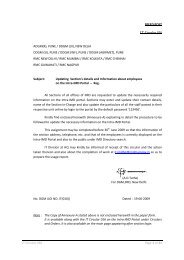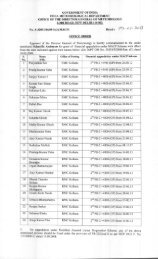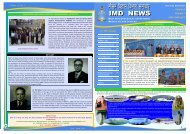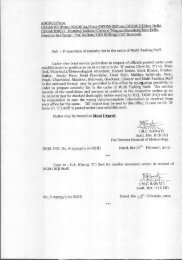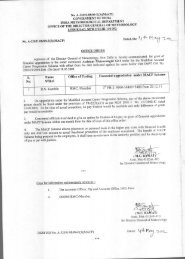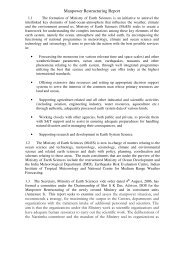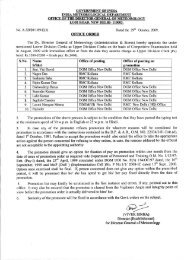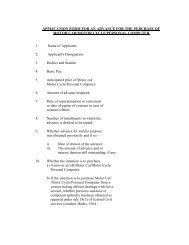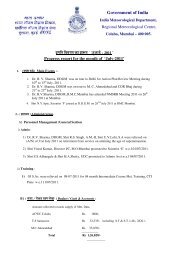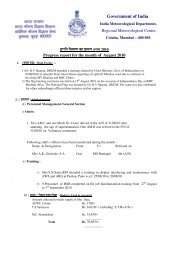1. Introduction - METNET : An e-Governance Intra-IMD Portal - India ...
1. Introduction - METNET : An e-Governance Intra-IMD Portal - India ...
1. Introduction - METNET : An e-Governance Intra-IMD Portal - India ...
Create successful ePaper yourself
Turn your PDF publications into a flip-book with our unique Google optimized e-Paper software.
17. Staff Statement Register:<br />
(i) Staff statement register indicating columns for name of the post, sanction No. with<br />
date, Group/Cadre, Number of posts, date of creation, plan/non-plan, remarks may<br />
be maintained at each M.C.. If post is transferred, same may be entered in remarks<br />
column.<br />
(ii) In separate pages of the register, columns for sanctioned post, actual posting,<br />
name of the incumbent, date of joining of incumbent may be prepared and if<br />
individual transferred/retired/promoted to higher post, same may be indicated in<br />
remarks column.<br />
(iii) In separate pages, details of the employee such as name with designation, date of<br />
joining in department with cadre post, date of birth, training particulars,<br />
knowledge of Hindi, working experience, transfer details, categorygeneral/SC/ST/OBC<br />
may be prepared.<br />
(iv) Staff statement register should be in the custody of Dir. I/C which may be<br />
accessible to A.M.(Admin).<br />
18. Employees whereabout register:<br />
(i)<br />
Present address, permanent address, residence telephone number, mobile number,<br />
joining date at the station and his previous posting station name of each employee<br />
may be maintained in separate pages for future reference in case of missing of<br />
employee or absconding, not returning duty after expiry of leave etc.<br />
19. Record Management<br />
(A)<br />
Records management is the practice of maintaining the records of an organization<br />
from the time they are created up to their eventual disposal. This may include<br />
classifying, storing, securing, and destruction (or in some cases, archival<br />
preservation) of records. A record can be either a tangible object or digital<br />
information: for example, birth certificates, medical x-rays, office documents,<br />
databases, application data, and e-mail. Records management is primarily<br />
concerned with the evidence of an organization's activities, and is usually applied<br />
according to the value of the records rather than their physical format. Activities<br />
of record management are given below:<br />
<strong>1.</strong> CONTROLLING CREATION<br />
2. CATEGORISATION<br />
3. TRANSFER<br />
4. MAINTENANCE<br />
5. PRESERVATION<br />
6. RETRIEVAL<br />
7. RESTORATION<br />
8. REVIEW<br />
9. WEEDING<br />
(B)<br />
Records management principles and automated records management systems aid<br />
in the capture, classification, and ongoing management of records throughout their<br />
8



